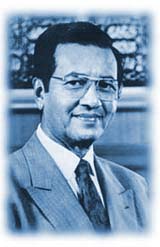 "Telecommunication
that connects a patient and a health care provider through live
two - way audio, two - way video transmission across distances
and that permits effective diagnosis, treatment and other health
care activities."2
"Telecommunication
that connects a patient and a health care provider through live
two - way audio, two - way video transmission across distances
and that permits effective diagnosis, treatment and other health
care activities."2
TELEMEDICINE
The essence of telemedicine is the exchange of information at
a distance, whether that information is voice, an image, elements
of a medical record, or commands to a surgical robot. The
development of high speed data transmission links on the
information superhighway has stimulated a new burst of activity1.
The prefix, "tele" from the Greek "telos",
implies only distance, but telemedicine has been defined more
recently in terms of advanced communications technology,  "Telecommunication
that connects a patient and a health care provider through live
two - way audio, two - way video transmission across distances
and that permits effective diagnosis, treatment and other health
care activities."2
"Telecommunication
that connects a patient and a health care provider through live
two - way audio, two - way video transmission across distances
and that permits effective diagnosis, treatment and other health
care activities."2
Our Prime Minister's vision and desire to see Malaysia attain developed nation status by the year 2020 has been the catalyst to develop IT in Malaysia. The establishment of MSC (Mutimedia Super-Corridor) is intended to facilitate our transition into an Information Age multimedia economy, helping us remain competitive in the global marketplace3. What does the MSC hold for Malaysians? The MSC applications include the setting up of
The Electronic Government is a multimedia-networked paperless administration which links Putrajaya to government centres around the country. It facilitates inter-governmental collaboration and give citizens better access to government services.
Schools will be networked and equipped with computer resources to develop personalised, interactive courseware and to access information from around the world.
The worldwide Manufacturing Web is a hub for remote manufacturing, coordinating and engineering that enables companies in high-cost countries to electronically access lower-cost manufacturing facilities across Malaysia and Asia as a virtual extension of their domestic operations.
This is a multimedia customer service hub leveraging Malaysia's unique multi-cultural and multi-lingual links to provide electronic publishing, content localisation, tele-marketing and remote customer services to over 2.5 billion people in Asia-Pacific region.
These are collaborative clusters comprising universities and corporate R&D centres, using distance-learning techniques to produce world-class graduates and next generation innovations.
The National Multi-Purpose Card will be the world's first smart card which will have an individual's ID and electronic signature, giving him or her access to government, banking, credit, telephone, transport, club and other services.
The highly convienent location and the high-tech facilities of the MSC makes it an ideal off-shore tax haven for wealthy individuals and companies. It will have direct multimedia links to financial centres around the world and to Labuan, Malaysia's offshore financial centre.
And of course,
The Telemedicine network will link medical centres and healthcare providers with the world's best medical experts and databases. Features: high definition imaging and transmission systems, secure multimedia networks, electronic document imaging of all medical records, remote diagnosis, treatment and training, integreted pan-industry healthcare distribution and utilisation chain. Scale: 111government hospitals, 206 private hospitals, 9608 doctors, 50 insurance companies, 135 healthcare product suppliers, with 7.055 million medical records and 10.798 million case notes as first base.
Today, the use of Internet to transfer information, be it by email, IRC, audio, video is already available in our country. Where there are no telephone lines, mobile phones or satellite assisted communication can be utilised and even this can be connected to the Internet. A digital camera, a scanner, modem, computer, colour printer and a telephone line is all that one needs. Two-way audio/video transmissions is also possible.
Just a word of caution. Technology has the power to mesmerise and the desire to possess the latest gadget and the fear of being left behind in a technological revolution may prove irresistible to some. What is important is the application of information and communication technologies in health care, should be problem rather than technology driven. Where possible the use of existing communication technologies such as telephones, faxes, mobile telephones, voice mail, and email may significantly improve delivery of health care2. I feel it is relevant when we are embarking in this new era of information technology that we weigh the difference between what is practical and what is ideal. The answer I believe lies somewhere in-between.
Below are some links to telemedicine related articles and sites for further information.
Articles and sites
More links
Till next month, "Happy Surfing".
References.
1. Recent Advances. Medical informatics. (http://www.bmj.com/archive/6991ed1.htm)
2. Telemedicine: lessons remain unheeded.(http://www.bmj.com/archive/6991ed3.htm)
3. Cybernation In The Making. Computerworld Special. A guide to Malaysia's IT landscape.

M.Vadivale (vadivale@geocities.com) "Cyberdoc"
The links to URL mentioned above are valid at the time of writing (12 August 1997).
This page can be accessed at http://www.vadscorner.com/internet6.html or at http://www.vadscorner.com/mma_internet.html.
Links last updated 20 April 2005